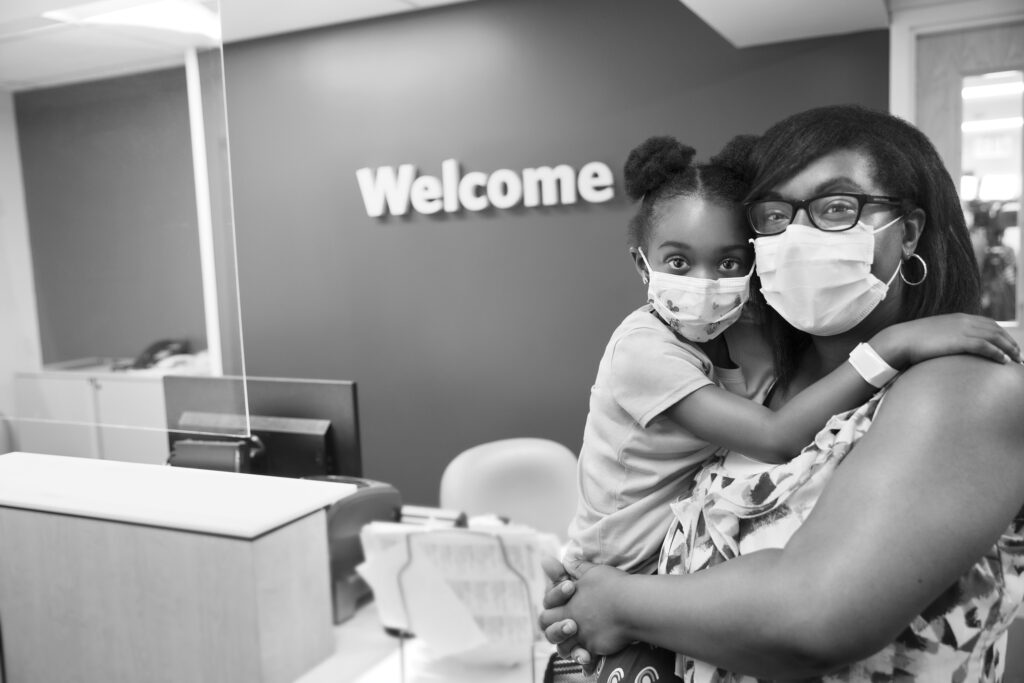Integrating Behavioral Health and Primary Care Increases Access and Equity
Integrating Behavioral Health and Primary Care Increases Access and Equity https://pediatricsnationwide.org/wp-content/uploads/2022/09/080320ds5120HR_TV_Adjusted-1024x683.jpg 1024 683 Mary Bates, PhD Mary Bates, PhD https://secure.gravatar.com/avatar/c6233ca2b7754ab7c4c820e14eb518c8?s=96&d=mm&r=g- September 22, 2022
- Mary Bates, PhD

With mental health concerns on the rise, more primary care providers are integrating behavioral health services in their practices.
Despite increasing demand for behavioral health care, multiple barriers still exist that limit access for pediatric patients. In recent years, primary care settings across the country have responded by integrating mental health specialists into their practices. Now, a growing body of evidence suggests that integrating behavioral health services into pediatric primary care can reduce health disparities, improve outcomes and increase both patient and provider satisfaction.
In December 2021, the U.S. surgeon general released an advisory declaring the mental health challenges facing children and teens a “national crisis.” The report noted that the COVID-19 pandemic has exacerbated an ongoing rise in depression, anxiety, self-harm and other behavioral health issues among youths. At the same time, there is a shortage of pediatric mental health specialists to meet the need.
Mental health disorders impact up to 40% of children and adolescents, but only 30% of them receive care, and on average, they experience a delay of 8 to 10 years between symptom onset and intervention.
The primary care office is often the place where behavioral health issues are first raised. About half of all pediatric primary care office visits involve behavioral or psychosocial concerns, says Cody Hostutler, PhD, a psychologist at Nationwide Children’s Hospital.
“Primary care is one of the front doors to the mental health system. It’s the first place that most parents go when they have a concern about their child’s behavior or development,” he says.
However, many pediatric providers feel that they don’t have the training or time to adequately manage behavioral health needs and have a hard time finding help.
To address these issues, some health systems have adopted integrated behavioral health strategies — systemic and physical structures where pediatricians and mental health specialists work together to care for children’s holistic health and development.
“Primary care is one of the front doors to the mental health system. It’s the first place that most parents go when they have a concern about their child’s behavior or development.” — Cody Hostutler, PhD
Nationwide Children’s Integrated Approach
At Nationwide Children’s, efforts to integrate behavioral health and primary care took off in 2016. At that time, many of the hospital’s specialty medical clinics already had integrated psychologists. Dr. Hostutler was part of the team that spearheaded the move to a highly integrated model of behavioral health care in primary care settings.
“Presently, we have integrated behavioral health in just under half of our 14 primary care clinics, and we are working to place psychologists at each one,” says Alex Kemper, MD, MPH, MS, division chief of Primary Care Pediatrics at Nationwide Children’s. “As part of our well child checks, we focus on growth and development and promoting optimal outcomes, and behavioral health is central to that.”
For the integrated psychologists at Nationwide Children’s, about 20-25% of their daily appointments are scheduled follow-ups or further assessments. The bulk of their days are intentionally kept open, allowing them to jump in and assist with patients as needed.
Whitney Raglin Bignall, PhD, a psychologist at Nationwide Children’s Linden Primary Care Center, says that the emphasis on seeing patients and families on the day of their primary care appointment is a unique and important aspect of the hospital’s integrated model.
“Even though patients are coming in to see one of our primary care providers, there is an understanding that I might see them that same day, too,” she says. “I review all the charts and read notes while they are in appointments because I am anticipating that I might get a chance to see that family that day.”
As a psychologist in a primary care center, Dr. Raglin Bignall’s work is varied but she says her goal is to leave every family with an understanding of the issue and the first few steps of a plan to move forward.
“A big part of our job is to take some of the stress off our pediatricians and other providers, while giving families some immediate strategies and a plan for the next step,” she says.
The work that integrated psychologists do at Nationwide Children’s can run the gamut. They are there to address serious mental health concerns, such as anxiety and depression, but also to help families with common issues like toilet training, pill swallowing, fear of vaccines and temper tantrums.
Even before concerns arise, Dr. Raglin Bignall and other integrated psychologists will pop into wellness visits for children as young as two months old to introduce themselves to families.
“It’s not just about behavioral health crises,” she says. “It’s about how we develop those relationships early and prevent problems later on.”
“Behavioral health integration is so much more than just therapy in the primary care setting,” agrees Dr. Hostutler. “At Nationwide Children’s, we are full partners in care, ready to jump in as needed to improve physical and mental health.”
“My job is so rewarding. I get to meet families and grow with them. And I get to work in this team where we think holistically about children’s health. I work with schools and the community, as well — it’s so much broader than just an office visit and it allows me to do a better job.” — Whitney Raglin Bignall, PhD
Models of Integrated Behavioral Health Care
The highly integrated approach to behavioral health at Nationwide Children’s falls at one end of a continuum of models of integrated care. These are typically organized into coordinated, co-located, and integrated models, depending on the level of integration of primary care providers and mental health specialists.
In coordinated models, mental health services are coordinated with primary care but are not provided in the primary care practice. Coordinated models often involve telehealth-delivered services such as providing information or updates to the primary care provider and facilitating referrals.
Co-located care refers to providing behavioral health services within the same clinic as a primary care provider but without significant collaboration between providers. In this model, the pediatrician and psychologist work in parallel at the same clinic, rather than being partnered.
Integrated models provide collaborative services within the primary care setting and involve the primary care provider and mental health specialist working together to care for patients.
Clinics can also use variations or combinations of these models to fit their specific needs. In addition to their highly integrated primary care clinics, Nationwide Children’s also incorporates co-located therapy to its model so that patients needing more support can receive therapy within the primary care office on their own schedules.
Benefits to Providers
Integrating behavioral health into primary care can allow pediatricians to see more patients and improve the overall efficiency of the clinic, says Dr. Kemper, who is also a professor of Pediatrics at The Ohio State University College of Medicine.
“If there is something complex or needing extra attention, the psychologist can go into the room and address that with the patient and the family while the pediatrician goes and sees other patients and comes back,” he says.
Integration also allows primary care providers to focus on the services they feel more comfortable delivering. Pediatricians may be more likely to ask their patients about behavioral health concerns, knowing that they can be addressed by an integrated mental health specialist that same day.
Primary care providers also appreciate the opportunity that integration provides them to learn from their colleagues. Working closely with mental health specialists allows pediatricians to acquire new strategies and build their skills, which can help them feel more confident in caring for their patients’ mental health needs.
Integrated behavioral health providers benefit from working within these models of care, too, says Dr. Raglin Bignall.
“My job is so rewarding. I get to meet families and grow with them,” she says. “And I get to work in this team where we think holistically about children’s health. I work with schools and the community, as well — it’s so much broader than just an office visit and it allows me to do a better job.”
Increasing Access and Equity
In addition to the benefits to providers, integration also affords opportunities for pediatricians and mental health specialists to better coordinate treatment, resulting in several advantages for patients and families.
“Usually, without having a behavioral health provider in the clinic, physicians have to put in a referral,” says Dr. Raglin Bignall. “And especially in these times, there is a huge need and the wait lists are long. Families end up having to wait a long time to get help.”
Families often prefer an integrated model because it gives them the chance to meet with a mental health specialist the same day they present with a concern.
“About 93% of the kids we see are seen on the same day they bring up their concerns to the physician,” says Dr. Hostutler. “The wait time is a few minutes, not a few months. We say we provide the right service at the right time.”
Scheduling behavioral health follow-ups within the primary care setting can also help reduce the stigma of receiving mental health care. When a mental health specialist has been involved in wellness visits from infancy on, behavioral health becomes a standard part of raising a child and receiving medical care. Both patients and families may be more comfortable asking for and receiving mental health help in this context.
“Integration seems to be a more palatable, tolerable, accessible, less stigmatizing approach to treatment for a lot of people,” says Dr. Hostutler. “By engaging in mental health treatment in collaboration with a primary care physician who knows the family and has their trust, and by doing it in a medical setting, more people are willing to engage in treatment.”
At Nationwide Children’s, integration has resulted in a tripling of the number of patients accessing behavioral health providers. At the same time, there has been a one-third reduction in referrals to behavioral health providers outside of the clinic.
“Integration triples access while reducing the number of kids referred out to a mental health professional in the community,” says Dr. Hostutler. “The fewer referrals we send to providers in the community, the more availability they have and the shorter their waitlists.”
Data from Nationwide Children’s and at the national level suggest that behavioral health integration reduces barriers and improves equity in access to quality mental health care. Additionally, integration often leads to a reduction in emergency room visits and hospital stays for mental health crises, resulting in reduced costs. When behavioral health providers work collaboratively with primary care physicians, all parties benefit.
Integrated Approaches for Any Clinic
Nationwide Children’s is leading by example with their integrated primary care clinics. But clinicians at the hospital are also sharing their resources and experience with primary care clinics across the state. A team at Nationwide Children’s, including Dr. Hostutler, works to scale behavioral health integration out into the community. They provide technical assistance to local primary care practices interested in integrating behavioral health care.
Looking for help integrating behavioral health into your primary care practice?
Reach out to the Nationwide Children’s support team below
Dr. Hostutler emphasizes that “integrated care” encompasses a diverse set of services and there is no “one-size-fits-all” approach.
“There are some people who like to cook by recipe and then there are people who like to cook by ingredients, based on what they have at hand,” he says. “When we do our technical assistance to primary care clinics in the community, we cook by ingredient to develop personalized models. That is how we help them create a model of integration that best fits their clinic and their patients’ needs.”
A highly integrated model might seem preferable. In practice, the choice of model and how it is implemented will vary between clinics based on several issues, including patient demographics, payer mix, and access to community-based referrals for ongoing mental health care. For instance, if a clinic sees an overwhelming amount of substance misuse, it might make sense to specifically focus on screening and treating that issue. Or if a clinic is in an area where patients have fewer barriers to attending appointments and following through with referrals, a co-located model could work.
“There is no question that the integrated model improves health outcomes for patients and improves the quality of life for the families that we take care of,” says Dr. Kemper. “Behavioral health integration is a no-brainer and once you see it in action, the benefits are remarkable.”
References
- Boyle P. Doctors team up to take on youth mental health crisis. Association of American Medical Colleges News. 3 Feb 2022. Accessed 19 Aug 2022. https://www.aamc.org/news insights/doctors-team-takeyouth-mental-health-crisis.
- HHS Press Office. U.S. surgeon general issues advisory on youth mental health crisis further exposed by COVID-19 pandemic. Office of the Surgeon General. 7 Dec 2021. Accessed 19 Aug 2022. https://www.hhs.gov/about/news/2021/12/07/us-surgeon-general-issues-advisory-on-youth-mental-healthcrisis-further-exposed-by-covid-19-pandemic.html.
- Hostutler C. Considerations for integrating behavioral health and primary care. Pediatrics Nationwide. 14 Nov 2017. Accessed 19 Aug 2022. https://pediatricsnationwide.org/2017/11/14/considerations-for-integrating-behavioral-health-and-primary-care/.
Image credits: Nationwide Children’s
About the author
Mary a freelance science writer and blogger based in Boston. Her favorite topics include biology, psychology, neuroscience, ecology, and animal behavior. She has a BA in Biology-Psychology with a minor in English from Skidmore College in Saratoga Springs, NY, and a PhD from Brown University, where she researched bat echolocation and bullfrog chorusing.
-
Mary Bates, PhDhttps://pediatricsnationwide.org/author/mary-bates-phd/December 27, 2016
-
Mary Bates, PhDhttps://pediatricsnationwide.org/author/mary-bates-phd/
-
Mary Bates, PhDhttps://pediatricsnationwide.org/author/mary-bates-phd/
-
Mary Bates, PhDhttps://pediatricsnationwide.org/author/mary-bates-phd/
- Posted In:
- Clinical Updates
- Features









